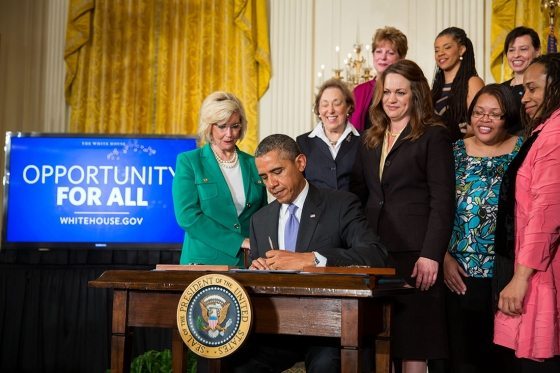On Equal Pay Day, Obama Takes Executive Action to Close Gender Wage Gap (Updated)
President Obama signed two executive actions on Tuesday, National Equal Pay Day, that are designed to help close the gender wage gap for federal contractors, the day before Congress voted on whether to pass similar measures for the private sector as well.

UPDATE, April 9, 2:55 p.m.: On Wednesday, Senate Republicans blocked the Paycheck Fairness Act from advancing forward in a 53-44 vote along party lines.
President Obama signed two executive actions on Tuesday, National Equal Pay Day, that are designed to help close the gender wage gap for federal contractors, the day before Congress votes on whether to pass similar measures for the private sector as well.
One executive order will prohibit employers from retaliating against employees who share information about their wages with each other. Goodyear became famous for prohibiting such disclosures when long-time employee Lilly Ledbetter, who appeared with the president at a press conference Tuesday, learned from an anonymous note that she had been making thousands of dollars less than her male coworkers for almost 20 years. The Lilly Ledbetter Fair Pay Act of 2009, the first bill signed by the president after he took office, loosened restrictive statute of limitations laws that had prevented Ledbetter from suing her employer for back pay.
The other new executive action is a presidential memorandum requiring federal contractors to provide data about employee compensation, including breakdowns by sex and race.
“There are plenty of employers out there who are absolutely certain that there’s no pay discrimination happening in their offices. But then sometimes when the data is laid out, it paints a different picture,” Obama said at the event on Tuesday before signing the new measures.
The National Women’s Law Center estimates that, on average, white women make 78 percent of white men’s full-time wages, which is close to the often-cited average of 77 percent (or “77 cents for every dollar”) for all women. But African-American and Latina women make only 64 percent and 54 percent, respectively, of what a white man makes. Women of color also face a gender gap, albeit a smaller one, compared to Black and Latino men, who face their own wage gap of 73 cents and 61 cents, respectively, for every dollar made by white men.
About one-quarter of the U.S. workforce is made up of federal contractors.
Obama urged Congress to follow his lead by passing the Paycheck Fairness Act, which would amend the 1968 Equal Pay Act to say that pay differentials must be based on “bona fide factors” other than sex that are job-related and necessary for business. The act would also make employers civilly liable for unequal pay.
Obama didn’t mince words in accusing Congressional Republicans of “gumming up the works” on not just equal pay, but any and every piece of legislation designed to help working families. He argued that equal pay for women will benefit the economy as a whole because women make up half the workforce and are often family breadwinners. He also chided Republicans for ignoring the three-quarters of Americans who support raising the minimum wage, and noted that the majority of minimum-wage workers are women.
“If Republicans in Congress want to prove me wrong, if they want to show that they, in fact, do care about women being paid the same as men, then show me,” Obama said. “They can start tomorrow. They can join us in this, the 21st century, and vote yes on the Paycheck Fairness Act.”
The 77-cents-on-the-dollar figure is sometimes disputed in discussions of the wage gap. The overall gap changes somewhat depending on whether you count annual wages or weekly wages, and the gap is not explained by outright wage discrimination alone. The gap also exists because of “life choices” such as taking time off for child care, only working part-time, or working in lower-paying fields—”choices” that many advocates argue are not neutral.
As writer and activist Soraya Chemaly notes, “Women’s ‘choices’ remain defined and constrained by institutionalized sexism and racism [and] implicit biases … that start at birth and never end.” Chemaly also notes that the United States has one of the worst gender pay gaps in the world, and that it has gotten worse since 1990 due to poor family and work policies.
“It’s not a myth; it’s math,” Obama said Tuesday, responding to commentators who claim that the pay gap is not real. “I mean, Lilly Ledbetter didn’t just make this up.”
The White House itself also has a gender wage gap of about 88 cents on the dollar.
U.S. House Speaker John Boehner (R-OH) tweeted in support of Equal Pay Day on Tuesday. His office did not return requests for comment on whether he will also support the Paycheck Fairness Act, but such support seems unlikely given his previous opposition to the act, and its unpopularity with Republicans.
The Paycheck Fairness Act has failed to pass twice before and may fail again this year if it faces a filibuster, but some states have taken similar action on their own. New Hampshire, for instance, has an equal pay law that has already passed the state senate and appears poised to both pass the house and be signed by the governor.
